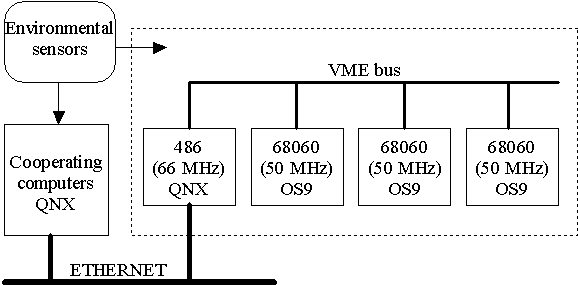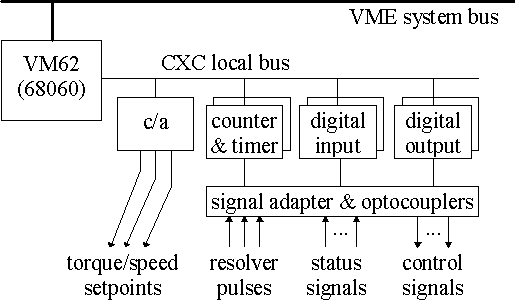A new project is being realized in the robotics laboratory now. A high speed robot is under construction. This includes mechanical hardware, motor drivers, a digital control workstation and control system software. The open hardware and software control architecture enables the educators and researchers to influence any level of the control hierarchy. The control system will provide the capability to modify any part of the control system (e.g. the trajectory generation, the servo-level control algorithms). It can also serve as a direct-drive manipulator development package. The future user can begin an advanced robotic research program or a graduate level course in robotics or control.
![]() Mechanical construction
Mechanical construction
The manipulator is being designed and built in the Institute of Aeronautics and Applied Mechanics. This is to be a six degree-of-freedom arm with three main axes driven by powerful high torque direct drive motors, and three other axes driven by much smaller conventional alternate current motors.
![]() Direct Drive Motors
Direct Drive Motors
The main axes are actuated by direct drive motors of 400, 100 and 60 Nm torque. They are controlled by motor drivers (manufactured by Yokogawa). The motors are being coupled to the arm without any gearbox. The range of the arm movement is unlimited in that the arms can revolve many times around their axes. The maximum speed of the direct drive motors is 2 revolutions per second, and the accuracy of the motor positioning is 0.0007o (500 000 increments per revolution).
![]() Anatomy of the robot controller
Anatomy of the robot controller
The control system was designed for research and educational purposes with two goals in mind. First, it had to be flexible and modifiable with respect to control algorithms applied to particular axes. Second, the interfacing of the system to additional devices, such as environmental sensors and other robots, should be possible with only limited effort. The users of the device are likely to play with different types of control algorithms for particular axes. This imposes an additional requirement on the control system of the robot - it should be very flexible and a modification of the control algorithm should be possible with only limited effort.
The required performance of the control system cannot be met by a single microprocessor. Therefore, a four processor architecture has been developed, with a single processor running high level task and three other processors running SERVO tasks for two robot axes each.
The computer hardware selected for the development of the robot control system is based on an industrial VME-based computer kit from PEP Modular Computers. The hardware is able to work in a multiprocessor configuration composed of Intel 486 and Motorola 68060 processor boards. The selected architecture of the robot control system consists of a single Intel 486 processor board and three Motorola 68060 processors boards connected to VME bus (Fig. 2) and mounted within a single rack, together with nearly fifteen interface circuit boards. The processors can communicate with each other through common memory areas accessible via VME bus and can exchange interrupt signals. Both 68060 processors act as axis controllers and execute SERVO control tasks, while 486 performs the supervisory task. Moreover, the supervisory processor can cooperate through a network with external computers, thus creating a distributed control system with enormous power and flexibility.

A dual bus architecture has been selected in which the interface boards are coupled to local buses of particular axes processors (Fig. 3). VME bus is used as the main system bus for inter-processor communication only. Relatively low actual load on the main bus preserves the potential for future system expansion, as additional robot-related sensors, not assigned to particular axes, can be interfaced to the supervisory processor through the VME bus.

The interface to a motor driver consists of an analog torque or speed setpoint signal, quadrature pulse signals from relative resolver and a number of bi-stable status and configuration signals. An external synchronization sensor supplements each axis hardware.
![]() Two Real Time Operating Systems
Two Real Time Operating Systems
The operation of Intel 486 is controlled by QNX, a multitasking, distributed real-time operating system from QNX Systems Software. The operation of 68060 is controlled by OS-9, a multitasking, real-time operating system from MicroWare.
![]() Computing speed
Computing speed
The performance requirements impose hard real-time constraints on the robot control operation, and particularly on the operation of the axes controllers implemented by 68060/OS-9 computers. Each SERVO task must be executed once per 100us. Real-time constraints imposed on the operation of the robot coordinator implemented by 486/QNX computer are less critical, as supervisory task must be executed only once per 1ms.
The system is currently under development. So far the computer hardware has been assembled and debugged, basic software structures and control algorithms have been prototyped.